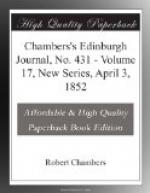With these feelings, we have thought it consistent with our duty as journalists, not to refuse publicity to an account of what was till lately doing in Paris to forward practical aerostation—we say, lately; for we are told by our correspondent, that the operations towards perfecting the invention have been stopped by orders of the French government, from an opinion that, if air-travelling were introduced, it would be injurious to the custom-house, and denationalise the country. This resolution of the French government is to be regretted, not less on the score of science, than from the ruin it has inflicted on the modest means of the ingenious operator. With these preliminary explanations, we offer the following paper, just as handed to us by a respectable party conversant with the details to which he refers.
’The chief difficulty in aero-locomotion, is that of steering; because the atmosphere seems to present no substantial fulcrum which can be pushed against. But that this difficulty is not altogether insurmountable, is evident from the single fact, that birds really do steer their way through the air. This fact suggests, that a fulcrum is not necessarily a palpable substance: it may be pliant or movable. For instance, if we fasten the string of a kite to a ball, this ball, which represents the fulcrum, being set in motion by the kite, becomes a movable fulcrum: a child also, holding the string in his hand, runs from right to left without impeding the motion of the kite, of which motion he is the movable fulcrum. Absolute stability, therefore, is not a necessary condition of a fulcrum; it is sufficient that there be, between the resistant force and the motive force, a difference of intensity in favour of the former. Thus, in water, the fulcrum, being liquid, is necessarily pliant and movable; yet it is quite possible, as every child knows, to obtain in this element purchase sufficient to steer the largest ships.
’In the air, which is a gas, the fulcrum being gaseous, must also be movable; but although the air, being the most elastic body with which we are acquainted, is therefore the least apt to furnish a fulcrum, yet, as compressed air is capable of bursting the strongest metallic receptacles, splitting the solid rock, and rending the bosom of the earth, it would seem that we have only to act upon the air through pressure, in order to obtain the requisite purchase from which to steer.
’Foremost among those who are thus endeavouring to render the balloon manageable, is M. Petin of Paris, who has devoted fifteen years to the study of this subject, the last three years to lecturing upon it in the principal towns of France, and who has unfortunately expended the whole of his resources in constructing an air-ship intended to demonstrate, on a small scale, the possibility of steering according to the system which he has elucidated. We say on a small scale; for though the dimensions of the curious construction in question, intended to carry two hundred passengers, will appear large to those of our readers whose ideas of ballooning have never gone beyond the ordinary ascensions so much in vogue at the present day, they are yet of almost microscopic minuteness when compared with the developments of which M. Petin and his friends conceive his plans to be susceptible!




